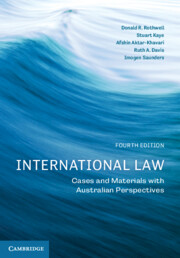Refine search
Actions for selected content:
37953 results in Cambridge Textbooks
Chapter 4 - International and municipal law
-
- Book:
- International Law
- Published online:
- 26 July 2025
- Print publication:
- 31 July 2025, pp 180-244
-
- Chapter
- Export citation
Chapter 1 - The nature of international law
-
- Book:
- International Law
- Published online:
- 26 July 2025
- Print publication:
- 31 July 2025, pp 1-49
-
- Chapter
- Export citation
Chapter 14 - Enforcement of international law
-
- Book:
- International Law
- Published online:
- 26 July 2025
- Print publication:
- 31 July 2025, pp 766-795
-
- Chapter
- Export citation
Chapter 10 - Law of the sea
-
- Book:
- International Law
- Published online:
- 26 July 2025
- Print publication:
- 31 July 2025, pp 546-605
-
- Chapter
- Export citation
Contents
-
- Book:
- International Law
- Published online:
- 26 July 2025
- Print publication:
- 31 July 2025, pp v-xii
-
- Chapter
- Export citation

Teaching the Arts
- Early Childhood and Primary Education
-
- Published online:
- 28 July 2025
- Print publication:
- 06 August 2025
-
- Textbook
- Export citation

International Law
- Cases and Materials with Australian Perspectives
-
- Published online:
- 26 July 2025
- Print publication:
- 31 July 2025
-
- Textbook
- Export citation
Appendix B - Equilibrium Excitation and Ionization Balance
-
- Book:
- Fundamentals of Astrophysics
- Published online:
- 10 November 2025
- Print publication:
- 24 July 2025, pp 284-286
-
- Chapter
- Export citation
5 - Labeling and Stigma As It Applies to Mental Illness
- from Part I - Theoretical Perspectives on Mental Health and Illness
-
-
- Book:
- Sociology of Mental Health
- Published online:
- 18 September 2025
- Print publication:
- 24 July 2025, pp 73-94
-
- Chapter
- Export citation
13 - Observational Methods
- from Part I - Stellar Properties
-
- Book:
- Fundamentals of Astrophysics
- Published online:
- 10 November 2025
- Print publication:
- 24 July 2025, pp 82-89
-
- Chapter
- Export citation
26 - Our Milky Way Galaxy
- from Part IV - Our Milky Way and Other Galaxies
-
- Book:
- Fundamentals of Astrophysics
- Published online:
- 10 November 2025
- Print publication:
- 24 July 2025, pp 201-212
-
- Chapter
- Export citation
19 - Immigration, Culture, and Mental Health
- from Part III - Mental Health Systems and Policy
-
-
- Book:
- Sociology of Mental Health
- Published online:
- 18 September 2025
- Print publication:
- 24 July 2025, pp 310-325
-
- Chapter
- Export citation
6 - Light Intensity and Absorption
- from Part I - Stellar Properties
-
- Book:
- Fundamentals of Astrophysics
- Published online:
- 10 November 2025
- Print publication:
- 24 July 2025, pp 35-42
-
- Chapter
- Export citation
6 - Stigma Resistance and Mental Illness Identity
- from Part I - Theoretical Perspectives on Mental Health and Illness
-
-
- Book:
- Sociology of Mental Health
- Published online:
- 18 September 2025
- Print publication:
- 24 July 2025, pp 95-110
-
- Chapter
- Export citation
32 - The Hot Big Bang
- from Part V - Cosmology
-
- Book:
- Fundamentals of Astrophysics
- Published online:
- 10 November 2025
- Print publication:
- 24 July 2025, pp 260-266
-
- Chapter
- Export citation
22 - Star Formation
- from Part III - Interstellar Medium and Formation of Stars and Planets
-
- Book:
- Fundamentals of Astrophysics
- Published online:
- 10 November 2025
- Print publication:
- 24 July 2025, pp 166-174
-
- Chapter
- Export citation
23 - Origin of Planetary Systems
- from Part III - Interstellar Medium and Formation of Stars and Planets
-
- Book:
- Fundamentals of Astrophysics
- Published online:
- 10 November 2025
- Print publication:
- 24 July 2025, pp 175-181
-
- Chapter
- Export citation
28 - Active Galactic Nuclei and Quasars
- from Part IV - Our Milky Way and Other Galaxies
-
- Book:
- Fundamentals of Astrophysics
- Published online:
- 10 November 2025
- Print publication:
- 24 July 2025, pp 223-231
-
- Chapter
- Export citation
Copyright page
-
- Book:
- Sociology of Mental Health
- Published online:
- 18 September 2025
- Print publication:
- 24 July 2025, pp iv-iv
-
- Chapter
- Export citation
Copyright page
-
- Book:
- Fundamentals of Astrophysics
- Published online:
- 10 November 2025
- Print publication:
- 24 July 2025, pp iv-iv
-
- Chapter
- Export citation
